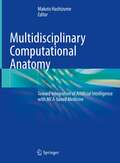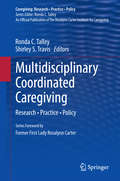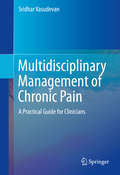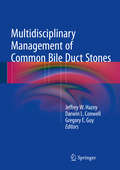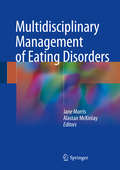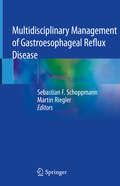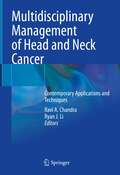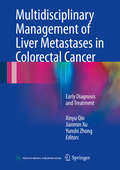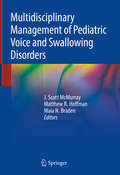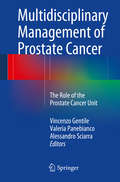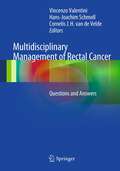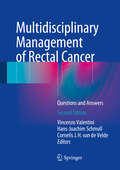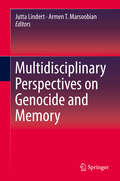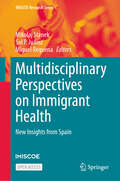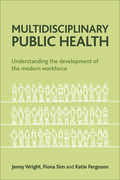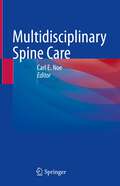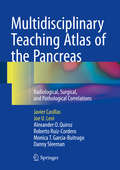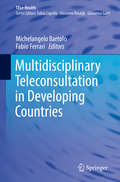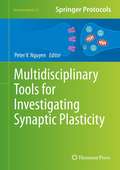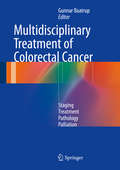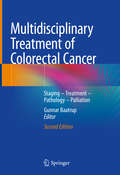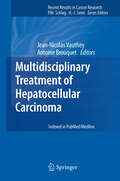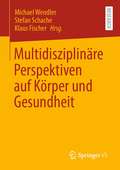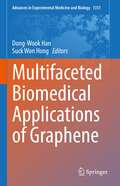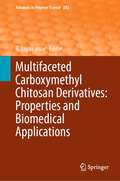- Table View
- List View
Multidisciplinary Computational Anatomy: Toward Integration of Artificial Intelligence with MCA-based Medicine
by Makoto HashizumeThis volume thoroughly describes the fundamentals of a new multidisciplinary field of study that aims to deepen our understanding of the human body by combining medical image processing, mathematical analysis, and artificial intelligence. Multidisciplinary Computational Anatomy (MCA) offers an advanced diagnosis and therapeutic navigation system to help detect or predict human health problems from the micro-level to macro-level using a four-dimensional, dynamic approach to human anatomy: space, time, function, and pathology. Applying this dynamic and “living” approach in the clinical setting will promote better planning for – and more accurate, effective, and safe implementation of – medical management. Multidisciplinary Computational Anatomy will appeal not only to clinicians but also to a wide readership in various scientific fields such as basic science, engineering, image processing, and biomedical engineering. All chapters were written by respected specialists and feature abundant color illustrations. Moreover, the findings presented here share new insights into unresolved issues in the diagnosis and treatment of disease, and into the healthy human body.
Multidisciplinary Coordinated Caregiving
by Ronda C. Talley Shirley S. TravisEffective, meaningful caregiving requires a well-coordinated and informed effort guided by various highly skilled specialists across several interrelated professions, including psychologists, social workers, and occupational therapists. Multidisciplinary Coordinated Caregiving addresses the information needs of these interrelated professionals, contributing to the direct care of individuals and serving as an essential resource for those who ultimately create collaborative approaches to contemporary caregiving plans. In addition, the volume provides a wealth of evidence-based research findings to facilitate ongoing dialogue about multidisciplinary and interdisciplinary perspectives on and interventions for the complex challenge of caregiving in America. Key areas of coverage include: The status of professional caregiving in the United States. Nursing perspectives on the state of family caregiving. Psychological aspects of caregiving. A human development, lifespan perspective on caregiving during late life. Public health contributions to caregiving. Multidisciplinary Coordinated Caregiving offers a wealth of insights for those researchers, practitioners, and graduate students who seek to optimize the care of individuals across such fields as psychology, social work, public health, geriatrics and gerontology, and medicine as well as public and educational policy making.
Multidisciplinary Management of Chronic Pain
by Sridhar Vasudevan"This book is a 'must have' resource in every physician/clinician practice setting. "--Martin Grabois, M. D. , Professor of PM&R, Baylor College of Medicine, Houston,TX. Dr. Vasudevan draws upon an accumulated reservoir of clinical expertise to provide readers with an up-to-date and highly readable guide to multidisciplinary pain management. . . . If only this book was available years ago"--Francis J. Keefe, PhD. Professor of Psychology, Psychiatry and Anesthesiology, Duke University, Durham, NC. This practical volume brings multidisciplinary innovations to the treatment of chronic pain. It argues expertly for the benefits of a biopsychosocial approach over current pain treatments more suited to acute care. The author's insights into the complexity of chronic pain and critiques of common but inconsistent unimodality pain management methods underscore the need for targeted multi-disciplinary pain programs. Among a wealth of useful clinical nuggets, readers will find guidance on adding "virtual" support to a pain management team, details on ways patients can take an active role in dealing with their chronic pain, and the original concept of the "back attack. " Included in the coverage: Pain theories and factors behind chronic pain--its application in treatment. Cognitive behavioral coping strategies. Treatments that have questionable or controversial evidence. Evaluation of disability in patients with chronic pain. Creating a virtual multidisciplinary team. Common pain problems: low back pain, complex regional pain syndrome, myofascial pain syndrome, fibromyalgia. Multidisciplinary Pain Management will enhance the work of diverse practitioners, including health and clinical psychologists, family and other primary care physicians, psychiatrists, occupational and physical therapists, and rehabilitation specialists.
Multidisciplinary Management of Common Bile Duct Stones
by Jeffrey W. Hazey Darwin L. Conwell Gregory E. GuyThis volume is a single resource highlighting multidisciplinary options available to clinicians for the management of common bile duct stones. The text highlights management, diagnosis, treatment options, and complications from the perspective of surgeons, gastroenterologists, and interventional radiologists, providing a truly multidisciplinary approach to treatment of these patients. By providing the scope of the problem to clinicians, the text increases awareness such that testing or referral to the most appropriate specialist (whether it be a gastroenterologist, surgeon or radiologist) can be initiated. Providing surgeons, gastroenterologists and radiologists alike access to the most current treatment paradigms in their field, Multidisciplinary Management of Common Bile Duct Stones empowers healthcare providers with interdisciplinary knowledge and options available to patients in management of their common bile duct stones.
Multidisciplinary Management of Eating Disorders
by Jane Morris Alastair McKinlayThis Handbook is an indispensable guide for the multidisciplinary management of eating disorders. It discusses a broad range of issues: managing high-risk patients, the challenges of inserting feeding tubes, addressing nutritional aspects and dealing with additional disorders which might complicate matters, such as diabetes, coeliac disease and cystic fibrosis. It discusses fertility, pregnancy, and eating disorders in children and adolescents, as well as addressing the needs of families. Chapters contain key checklists and flow diagrams. Abundant pictures and conversations, coloured diagrams, charts, maps and boxes, support readers’ varying learning styles and assist retention of key points. Vignettes taken from real (but strenuously anonymised) cases appeal to clinicians’ preference for case-based learning. The book also functions as a practical manual of ‘What to do – and what NOT to do’ with practical scenarios. In the acute situation, clinicians will be able to go directly to the relevant chapter to guide the team through the ‘when, where, how, why and with whom’ of assessing and managing patients with eating disorders. The book is primarily aimed at postgraduate physicians managing patients with Eating disorders on Gastrointestinal, Endocrine or general medical wards, and those who seek to deepen their expertise as they sit higher professional examinations. It is of interest to both medical and psychiatric clinicians, as well as useful to nursing and multidisciplinary staff who want to develop a compassionate understanding of the true pain driving their patients’ behaviours.
Multidisciplinary Management of Gastroesophageal Reflux Disease
by Sebastian F. Schoppmann Martin RieglerThis book presents a new, multi- and interdisciplinary approach to gastroesophageal reflux disease (GERD) and Barrett’s esophagus that reflects the latest advances in understanding of the disease. The role of each of the available diagnostic techniques, including endoscopy, histopathology, esophageal manometry, reflux monitoring, and EndoFLIP assessment, is carefully explained. The use of endoscopy for the purposes of mucosal ablation (radiofrequency ablation, cryoablation) and mucosal resection is described, and all aspects of anti-reflux surgery are covered, with detailed explanation of indications and techniques for standard fundoplication, endoscopic fundoplication, and surgical procedures using the LINX system and the EndoStim device. To assist the reader further, a novel interdisciplinary algorithm is presented for GERD diagnosis and treatment. In addition, the latest diagnostic and therapeutic approaches (including endoscopic and surgical resection and chemoradiation) are also presented for esophageal cancer and cancer palliation. A key feature of the book is its recognition of the contribution of different specialties in the management of GERD, and it will accordingly appeal to a wide range of practitioners.
Multidisciplinary Management of Head and Neck Cancer: Contemporary Applications and Techniques
by Ravi A. Chandra Ryan J. LiThis book is a multidisciplinary guide to head and neck cancer.Head and neck cancer remains one of the most technically complex cancer subsites to manage. This field involves highly specialized, multidisciplinary management and collaboration amongst surgeons, radiation oncologists, medical oncologists, radiologists, pathologists, and other health disciplines. The clinical and research landscape for head and neck oncology continues to evolve at a rapid pace. This multidisciplinary book provides the latest updates in the contemporary understanding and management of these tumors. The text incorporates updates in surgical techniques (minimally invasive and robotic techniques, reconstructive approaches), radiation medicine (new data on dose and fields, oligometastatic/oligoprogressive disease, retreatment), medical oncology (targeted, immunotherapy and molecular agents), in addition to other overarching topics such as side effects, biomarkers/nanotechnology, and epidemiology. Written by experts in their respective fields, chapters include the most up to date scientific and clinical information with perspectives from each relevant subspeciality. These sections are concise and accessible, yet comprehensive. Palliative medicine, pathologic and imaging principles, and health systems/economics considerations are also described. This book is an ideal resource for clinicians, trainees, and researchers dealing with, and interested in, this challenging malignancy.
Multidisciplinary Management of Liver Metastases in Colorectal Cancer
by Xinyu Qin Jianmin Xu Yunshi ZhongThis book focuses on early diagnosis and multidisciplinary treatment, which is the key to preventing the occurrence of the liver metastases in colorectal cancer, and to increasing the resection rate of the liver metastasis foci and the 5-year survival after surgery. This book is divided into five parts: the introduction, basics, diagnosis, treatment and prevention. It has 20 chapters in total, covering the latest advances in colorectal cancer liver metastases epidemiology, pathogenesis, molecular diagnostics, marker screening, imaging technology, surgery, chemotherapy and prevention, etc. It provides professionals with up-to-date and comprehensive information on colorectal liver metastases. This book is relevant for senior surgeons and physicians working in oncology, general surgery, chemotherapy, digestive medicine, liver medicine and hepatic surgery.
Multidisciplinary Management of Pediatric Voice and Swallowing Disorders
by J. Scott McMurray Matthew R. Hoffman Maia N. BradenThis text provides a comprehensive review of the assessment and management of pediatric voice and swallow disorders from the perspectives of both the pediatric laryngologist as well as the speech-language pathologist whose collaboration is critical to effective clinical care. All chapters are written by experts in dual fields and formatted to present a straightforward approach to diagnosing and managing each disorder, including descriptions of relevant operative interventions. Multiple intraoperative photographs and illustrations depicting how to perform each surgical procedure are also included. Multidisciplinary Management of Pediatric Voice and Swallowing Disorders will serve as a useful step-by-step guide and resource not only for otolaryngologists and speech-language pathologists, but all members of the pediatric aerodigestive team and other providers caring for children affected by voice and swallowing disorders.
Multidisciplinary Management of Prostate Cancer
by Valeria Panebianco Vincenzo Gentile Alessandro SciarraProstate cancer is the most common neoplasm in men and its management is very complex, in terms of both diagnosis and treatment. In recent years the value of multidisciplinary management within a prostate cancer unit has been increasingly recognized. Such a multidisciplinary approach within a specialized unit involves a variety of specialists, including urologists, oncologists, radiotherapists, radiologists and pathologists. This book describes in detail the advantages of multidisciplinary management of prostate cancer. It opens by explaining the nature of the required multidisciplinary team and the potential benefits of the prostate cancer unit as a structure for the delivery of specialist multidisciplinary care. Epidemiological aspects favoring multidisciplinary management are described and each element of care within the context of the prostate cancer unit is then discussed; also has been described the role of advanced imaging (Multiparametric MRI) in the management of PCa. Early diagnosis, risk classification, treatment decision making, surgery, radiotherapy, medical therapies and health care support are all fully considered. This book will be informative and enlightening for all who are involved in the management of patients with prostate cancer.
Multidisciplinary Management of Rectal Cancer
by Cornelis J. Velde Hans-Joachim Schmoll Vincenzo ValentiniThis book seeks to promote an integrated approach among the various specialists involved in the management of rectal cancer with a view to ensuring that treatment is tailored appropriately to the individual patient. For ease of use, a question and answer format is employed. The focus is on those issues typically confronted during daily clinical practice in relation to risk factors, imaging, surgery, radiotherapy, and chemotherapy. The services of an outstanding panel of authors representative of the major European oncological societies have been acquired in order to formulate the questions and provide the answers. All who need assistance in addressing concerns that arise from the need for multidisciplinary management of rectal cancer will find the book to be an ideal source of helpful information.
Multidisciplinary Management of Rectal Cancer: Questions And Answers
by Hans-Joachim Schmoll Vincenzo Valentini Cornelis J. van de VeldeIn this book, a distinguished group of clinicians provide straightforward, focused answers to the questions most commonly confronted by a multidisciplinary team when caring for patients with rectal cancer. The format of the book is designed to aid optimal decision making in a multidisciplinary setting with respect to key issues in imaging, radiotherapy, chemotherapy, and surgery, all of which are considered in detail. Helpful guidance is also offered on risk factor identification, pathology procedures and their prognostic value, and multidisciplinary team management. The authors have been carefully selected for their expertise, and most have been involved in the management of the more significant trials published in Europe during the past decade.In an era in which all patients are entitled to access healthcare systems that deliver the highest quality of treatment within a safe environment, together with appropriate advice, support, and long-term follow-up, the multidisciplinary team is of central importance. This successful book, in its revised and updated second edition, is designed to provide all the guidance likely to be required by members of the multidisciplinary team at various stages of the pathway of care for patients with rectal cancer.
Multidisciplinary Perspectives on Genocide and Memory
by Jutta Lindert Armen T. MarsoobianThis book explores the memory and representation of genocide as they affect individuals, communities and families, and artistic representations. It brings together a variety of disciplines from public health to philosophy, anthropology to architecture, offering readers interdisciplinary and international insights into one of the most important challenges in the 21st century. The book begins by describing the definitions and concepts of genocide from historical and philosophical perspectives. Next, it reviews memories of genocide in bodies and in societies as well as genocide in memory through lives, mental health and transgenerational effects. The book also examines the ways genocide has affected artistic works. From poetry to film, photography to theatre, it explores a range of artistic approaches to help demonstrate the heterogeneity of representations. This book provides a comprehensive and wide-ranging assessment of the many ways genocide has been remembered and represented. It presents an ideal foundation for understanding genocide and possibly preventing it from occurring again.
Multidisciplinary Perspectives on Immigrant Health: New Insights from Spain (IMISCOE Research Series)
by Mikolaj Stanek Sol P. Juárez Miguel RequenaThis open access book analyses the ever-complex relationship between immigration and health in contemporary societies using the Spanish society as a case study. It addresses some of the main dimensions of migrant health in Spain, including migrant-specific vulnerability factors, health changes associated with time spent at the migratory destination, and differentiated problems of certain subpopulations of migrants. The book also examines some of the factors associated with migrant health and explores the mechanisms that might explain this nexus, such as early childhood development, adult and older age health conditions, health practices and coping skills, health culture, social support, physical environment, and access to medical care and health services. While contributing to the effort to create a more comprehensive view of the health status and outcomes of immigrants in developed societies, the book will prove to be a valuable resource to academics, health professionals, various levels of stakeholders and decision-makers, representatives of civil society, and NGOs.
Multidisciplinary Public Health: Understanding the Development of the Modern Workforce
by Fiona Sim Jenny WrightIncluding the voices of key protagonists in the development of the public health workforce, this book is an important addition to the history of public health in England. It charts events leading to the unique achievement, from 2003, of specialist status, equivalent to public health medical consultants, for those from non-medical backgrounds. Setting these changes in context it discusses implications for practitioners and the wider UK public health workforce. A lively and comprehensive review of policy change, Multidisciplinary public health: Understanding the development of the modern workforce concludes with a reflection on the new public health system under way in England, making useful comparisons with the rest of the UK. This is an invaluable resource for anyone with an interest in public health, including public health academics and relevant postgraduate students.
Multidisciplinary Spine Care
by Carl E. NoeThis book presents multiple aspects of spine care from the perspective of different disciplines. It's organized by sections focused on non-operative care, spine injections and procedures, perioperative care, operative care, pediatric care, and special topics. Each chapter has been written by a clinician whose active practice involves the topic of their chapter. Practical and clinically relevant, this book educates any practitioner who cares for patients with back and neck pain and other spine conditions about implementing a multidisciplinary team to treat the spine.
Multidisciplinary Teaching Atlas of the Pancreas
by Javier Casillas Joe U. Levi Alexander O. Quiroz Roberto Ruiz-Cordero Monica T. Garcia-Buitrago Danny SleemanThis innovative teaching atlas provides the reader with a practical approach to the diagnosis and management of the common and uncommon diseases that may involve the pancreatic gland. Its perspective is multidisciplinary, the authors being radiologists, surgeons, pathologists, and gastroenterologists who have worked together for the past 25 years. Very concise descriptions of clinical presentation, pathology, imaging, and management are provided for a great variety of pathologic conditions, and a wealth of illustrative material displays intraoperative appearances, gross specimens, histology, and radiological findings. Pancreatic surgery, including transplantation, is also discussed, and the final chapter presents a gallery of challenging and diverse cases. Specialists and residents in a range of specialties will find this atlas to be an invaluable aid, and it will also serve as an excellent reference for medical students.
Multidisciplinary Teleconsultation in Developing Countries (Tele-health Ser.)
by Michelangelo Bartolo Fabio FerrariThis book presents a replicable model of multidisciplinary teleconsultation, designed and set up by Global Health Telemedicine, that offers very significant health benefits in remote and rural areas of developing countries. The model is based on experiences gained in sub-Saharan Africa while training and cooperating with local health professionals within the DREAM program, managed by the Community of Sant’Egidio. This program has to date treated almost 300,000 patients across many countries and has provided health education and disease prevention training to tens of millions. It originated in the context of the fight against AIDS but has been extended to encompass other pathologies and to exploit the capabilities of new telemedicine technologies that allow multispecialist teleconsultation (hence the acronym now represents “Disease Relief through Excellent and Advanced Means”). In addition to thorough description of the program, readers will find reflections and analysis on logistical, technical, sociological, and epidemiological issues. The book is divided into thematic chapters with easy-to-understand graphics. It will be a readily accessible source of information for professionals in international cooperation and global health students and professionals.
Multidisciplinary Tools for Investigating Synaptic Plasticity
by Peter NguyenInvestigations involving incisive mechanistic dissection of various types of synaptic plasticity have revealed that it plays key roles in neural development, sensory information processing, cortical remapping following brain injury, perception, and behavioral learning and memory. Disruptions of synaptic plasticity may underlie neurological and behavioral disorders such as Alzheimer disease, Fragile-X syndrome, autism, and drug addiction. Multidisciplinary Tools for Investigating Synaptic Plasticity, therefore, assembles expert contributions that highlight techniques and strategies used in probing the cellular and molecular mechanisms of synaptic plasticity in the nervous systems of vertebrate and invertebrate species. Divided into three sections, this meticulous volume describes biochemical and genetic strategies for studying synaptic plasticity, behavior, neural development, and synaptogenesis, and also includes cellular electrophysiological and optical methods for interrogating a diverse array of mechanistic issues. As part of the Neuromethods series, this book contains the kind of detail and key implementation advice that maximizes successful results. Authoritative and invaluable, Multidisciplinary Tools for Investigating Synaptic Plasticity serves as an ideal primer for introducing researchers to specific techniques that will enhance their success at addressing novel questions in synaptic plasticity at the lab bench.
Multidisciplinary Treatment of Colorectal Cancer
by Gunnar BaatrupThis book is intended as the equivalent of the Swiss Army knife for all members of colorectal cancer (CRC) multidisciplinary teams and those training in the fields of CRC management. It describes how to organize the team and explains the basic principles within the different disciplines involved in the treatment and care of CRC patients. Important, up-to-date knowledge is provided on visualization techniques, surgery, oncological treatment, palliation, and pathology, with special focus on controversies and aspects of interest to all team members. Care has been taken to ensure that each specialty-specific chapter will be approachable for team members from other specialties or professions, thereby facilitating an effective interdisciplinary approach to teamwork. The authors include leading European doctors and scientists who have influenced the development of the multidisciplinary team concept as well as other aspects of high-quality, individualized treatment of CRC patients.
Multidisciplinary Treatment of Colorectal Cancer: Staging – Treatment – Pathology – Palliation
by Gunnar BaatrupThis book is a comprehensive reference work on the multidisciplinary team (MDT) management of colorectal cancer (CRC) patients that will meet the needs of all members of CRC MDTs and those training in the field. Important, up-to-date knowledge is provided on organization of MDTs, early intervention, surgery, oncology, imaging, pathology, and palliation, with special focus on controversies. This second edition has been thoroughly revised. It includes an entirely new section on the principles of treatment of significant polyps and early cancers and a total of 14 new chapters, including one on the early integration of palliative care. Every effort has been made to ensure that each specialty-specific chapter will be approachable for all team members, thereby facilitating an effective interdisciplinary approach to teamwork. The authors are leading European doctors and scientists who have influenced the development of the MDT concept as well as other aspects of individualized treatment of CRC patients.
Multidisciplinary Treatment of Hepatocellular Carcinoma
by Jean-Nicolas Vauthey Antoine BrouquetIt is now widely accepted that multidisciplinary collaboration and multimodality treatment approaches are important in improving the survival of patients with hepatocellular carcinoma. In this comprehensive textbook, internationally renowned experts in the field present and discuss the various strategies employed in the treatment of the disease. Up-to-date information is provided on the indications for and outcome of a range of treatment options, including surgical resection, liver transplantation, radiofrequency ablation, transarterial chemoembolization, yttrium-90 transarterial radioembolization, and systemic therapy. In addition, important background information is included on biology, pathology, staging, and imaging. This book will be particularly helpful to all professionals and trainees worldwide who have an interest in the diagnosis and treatment of hepatocellular carcinoma.
Multidisziplinäre Perspektiven auf Körper und Gesundheit
by Michael Wendler Klaus Fischer Stefan SchacheDie Begriffe Körper und Gesundheit sind (nicht erst) seit dem sogenannten body-, corporeal- oder somatic-turn Gegenstand sehr unterschiedlicher Disziplinen und Perspektiven: Die Komplexität der Zusammenhänge, Verschränkungen, Bedingungen des Gegenstandspaares Körper-Gesundheit bis hin zur Identifikation macht es erforderlich, multidisziplinär und multiperspektivisch vorzugehen. In diesem Band sind unterschiedliche Disziplinen und Perspektiven versammelt, die sich aus ihrer Fachgenese und wissenschaftlichen Position heraus mit Körper, Leib und Gesundheit beschäftigen, um v.a. Forschungsfelder zu erschließen und praxeologische Konsequenzen zu benennen.
Multifaceted Biomedical Applications of Graphene (Advances in Experimental Medicine and Biology #1351)
by Dong-Wook Han Suck Won HongThis book explains the fundamental characteristics and biofunctionality of graphene-based nanomaterials and provides up-to-date information on the full range of their biomedical applications. An introductory section gives an overview of the chemical composition and physical properties of graphene and its derivatives as well as their potential toxicity and biosafety. Detailed attention is then devoted to the potential of multifunctional graphene-based nanomaterials (MFGNs) to direct the differentiation of stem cells into specific lineages and induce tissue regeneration. Here, individual chapters address the application of MFGNs for the purposes of neurogenesis, osteo- and chrondrogenesis, myogenesis, and wound healing. Subsequent sections focus on the capability of MFGNs as agents for drug delivery, bioimaging, theranostics, and therapeutics as well as their effectiveness as biomimetic platforms for nanobiosensors, biochips, medical devices, and dental applications. The book will be essential reading for graduate students, scientists, and engineers in any of the biomedical research fields in which efforts are being made to utilize novel MFGN-incorporated composite materials and develop functional devices based on them.
Multifaceted Carboxymethyl Chitosan Derivatives: Properties and Biomedical Applications (Advances in Polymer Science #292)
by R. JayakumarThis edited collection deals with the structure-property relationships and biomedical applications of carboxymethyl chitosan derivatives in different fields. Readers will detailed overview of the preparatory methods involved in the derivatives of carboxymethyl chitosan and its interaction with metal ions. The chapters provide a detailed overview of the different types of carboxymethyl chitosan derivatives, including the preparatory methods involved, the interactions with metal ions, and the antimicrobial activities. These different forms of carboxymethyl chitosan derivatives are found to be potentially used in food packaging, in enhancing saltiness, as biosensors, and also as wound dressing. Chapters are also devoted to the fabrication and biomedical applications of carboxymethyl chitosan derivatives-based nanofibers as well as the interaction of carboxymethyl chitosan with blood in blood clotting and the underlying mechanism. Contributing authors additionally explore topics related to carboxymethyl chitosan-based hydrogels, films, scaffolds, fibers, and composites. Finally, this volume presents the current challenges in developing biomedical products based on carboxymethyl chitosan derivatives. This book will be of interest not only to chemists, but to all scientists working in the fields of material/environmental science, biological science, and biomaterials. These chapters are great resources for any researcher who works with structure-property relationships, biological interactions, and the applications of carboxymethyl chitosan derivatives in different biomedical fields.
